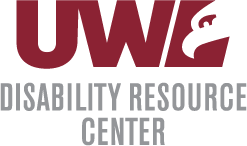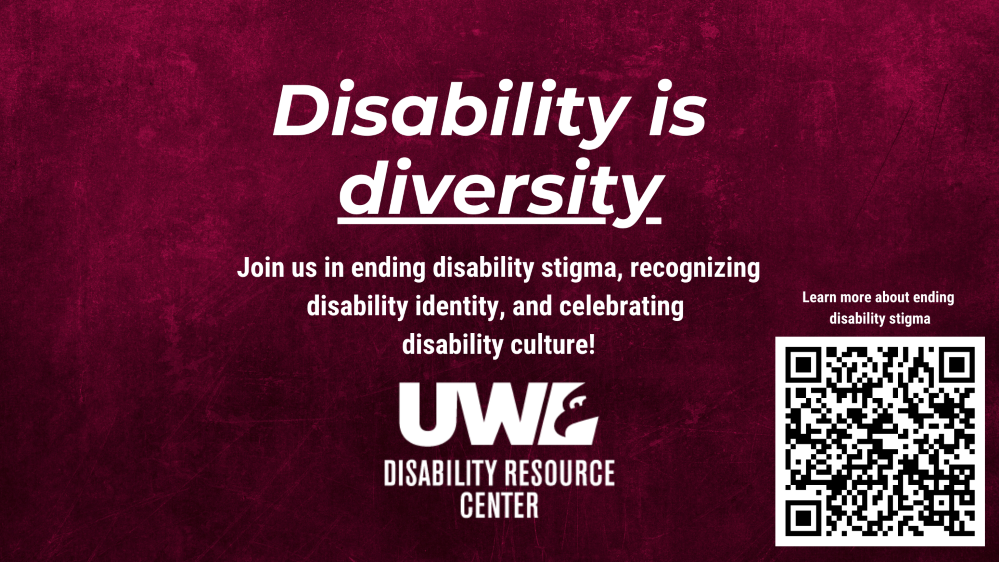Disability is not a bad word
A page within Disability Resource Center
The Disability is Not a Bad Word campaign is an effort to combat disability stigma through education. The Disability Resource Center recognizes that disability is a social identity with a rich culture. The disabled community has led efforts to create access to higher education through the Disability Rights movement and the Disability Justice Movement.
This page is dedicated to providing information about the models of disability, disability identity, the disability rights movement, and disability justice. We hope that you will explore this webpage and learn more about the vibrant disability community and how saying the word disability should be something we celebrate rather than something to avoid!
In order to make UWL more accessible we want to be sure that we as a campus acknowledge that disability is not a bad word. Disability is an important part of the fabric of our society and all people with disabilities deserve to have the access they need to fully participate at UWL. For more information We recommend you check out the following resources:
- Watch disability rights pioneer Stella Young's Ted Talk about the myths surrounding disability.
- Read Disability is Not a Bad Word: Why 'Unique Abilities' Isn't as Nice as it Sounds a blog post by Disability Rights: Florida.
- Read Disability is not a dirty word; ‘handi-capable’ should be retired, an article highlighting rehabilitation psychology research about language and disability.
- Read the Association on Higher Education and Disability's Statement on Language.
Models of Disability
Models of disability are devices that help us frame our understanding of the cause of disability, definitions of disability, and how to respond to disability. Our conceptualization of disability affects the decisions we make and our attitudes toward disability. Below are some models of disability that are commonly used.
Moral Model of Disability
Views disability as a moral consequence of some sort. For example, the moral model of disability may frame disability as a punishment for bad deeds done in the past, either by the individual or by their family. The moral model may also view disability as a positive moral attribute, such as a person having a disability due to an honorable act (e.g., a injured veteran) or because someone has the strength to overcome barriers due to their moral character. The moral model is prevalent today and often portrayed in the media. Often time the moral model looks to hide disability due to issues around shame.
Medical Model of Disability
Views disability as an individual medical condition. Healthcare providers are often centered as the experts about disability and the ultimate goal is to cure or eradicate disability. The medical model posits that disability is a bad thing, something undesirable, and focuses funding and decisions on curing disability. Prevalent in the healthcare system and through the work of charitable organizations that raise money toward cures. Often times the medical models looks to hide disability due to the undesirability of disability.
Social Model of Disability
Views disability as a social issue in which decisions are made to exclude different bodies and minds. The social model was the driving force behind the Disability Rights movement, which recognized that institutions, like higher education, were inaccessible to disabled people. The social model inspired work toward increasing visibility of disable people and demanded that social decisions are made increase access.
Political Model of Disability
Recognizes that people with disabilities are the largest minority in the United States. Due to the size, the disability community should take a more active role in influence political decisions that affect the health and wellbeing of other disabled people. The political model of disability asks all of us to envision a future that includes disabled people as planning future is an important part of the political process.
Other Resources
Check out these resources about Models of Disability!
- Watch disability rights pioneer Stella Young's Ted Talk about the myths surrounding disability.
- Read the American Psychological Association's Conceptualizing disability: Three models of disability by Dr. Rhoda Olkin
- Explore disabled-world.com's Models of Disability webpage.
What language should we use when discussing disability identity?
When discussing or addressing disability our words matter. There has been a lot of discussion about using person first language - a person with a disability - rather than identity first language - disabled person.
The reality is that it depends and many people have differing views as to whether they prefer identity first or person first language.
Identity first language - a disabled person - has been used by those that use the social model of disability (see the Models of Disability tab for more information) because it recognizes that a person is disabled by the world around them rather than the disability being something that accompanies them. Like other social identities, disability can be a source of immense pride and have cultural significance!
Person first language - a person with a disability - has been promoted to recognize the personhood of an individual. This is linked to a long history of dehumanization through the process of institutionalization and hiding of disability. People with intellectual and developmental disabilities often prefer person first language as their autonomy and personhood is often under question.
Using identity first language may seem uncomfortable due to the insistence that person first language is the only way to talk about disability. The truth is that both can and should be used as they recognize the diversity within the disability community!
Resources for further exploration
Check out these resources about identity first and person first language!
- Watch Disabled Person or Person with Disability on YouTube!
- Read Identity First Language from the Autistic Self Advocacy Network
- Read King's (2016) Disabled: Just #Saytheword article on National Public Radio
- Explore the ADA National Network's Guidelines for Writing About People With Disabilities
What is disability identity?
Disability identity is both an individual process and a social category. Disability includes an individual's sense of self (see Identity Development below) as well as a connection to the larger disability community. Due to the diversity within the disability community - physical, sensory, psychological, emotional, learning, intellectual, and developmental disabilities - cross-disability connections and solidarity can be difficult. Disability identity recognizes the diversity within the disability community as a strength.
Read Evan's (2017) Un/covering: Making Disability Identity Legible from Disability Studies Quarterly.
Identity Development
Like many other social identities, disability identity is an important developmental and social process for individuals with disabilities.
Forber-Pratt and Zape's Disability Identity Development Model identifies four developmental statuses see table below:
Table: Forber-Pratt and Zape's Model of Social & Psychosocial Disability Identity Development
| Status | Tasks |
| Acceptance Status |
|
| Relationship Status |
|
| Adoption Status |
|
| Engagement status |
|
The fight for equal opportunity and access
The modern Disability Rights movement began in the late 1960 with the expressed aim of eliminating societal barriers that limit access for disabled people. Inspired by the Civil Rights movement, Disability Rights advocated for legislative action championing many of the state and federal protections provided for students with disabilities today.
Section 504 of the Rehabilitation Act
Passed in 1973, the Rehabilitation Act included a non-discriminatory clause - Section 504 - which stated "No otherwise qualified individual with a disability in the United States... shall, solely by reason of his or her disability, be excluded from the participation in, be denied the benefits of, or be subjected to discrimination under any program or activity receiving Federal financial assistance".
However, the regulations enforcing Section 504 where not signed right away. In 1977, a group of disabled activists protested the Secretary of Health, Education, and Welfare and demanded the signing of those regulations. After the longest civil rights occupation of a federal building - 24 days - the regulations were signed.
Those Section 504 regulations are one of the reasons that offices like the Disability Resource Center exist on college campuses - ensuring equal access and opportunity to higher education.
Americans with Disabilities Act (1990)
Section 504 addressed disability discrimination within federal programs; however, disability discrimination was still happening in employment, within private organizations/businesses, as well as, public transportation.
Disability Rights activists continued to mobilize to create a more comprehensive disability rights bill. In March of 1990, disability activists participated in the Capitol Crawl, where disabled people crawled up the capitol steps in Washington D.C. to demand further protections.
In July 1990, the Americans with Disabilities Act (ADA) was signed into law. Disability Rights activists have continued to ensure that the promise of the ADA are realized. For example - in 2008 - the ADA was amended to ensure that the most inclusive interpretation of disability would be recognized. This expanded protections for people with psychological disabilities.
Learn more
Learn more about the disability rights movement below.
- Watch the documentary Crip Camp: A Disability Revolution
- Read the National Park Service's Disability History: The Disability Rights Movement
Disability Justice
In 2005 a group of queer, disabled activists of color came together to dream of a more intersectional approach of disability activism. The Disability Rights movement has been critiqued on moving forward a single-issue movement leaving out the experiences of people who hold multiple marginalized identities. For example, the disability experience of a woman of color is different than a white man. Disability Justice recognizes these intersections and believes that cross-movement building is essential for liberation and accessibility.
Learn more
Check out the 10 Principles of Disability Justice by Sins Invalid.









